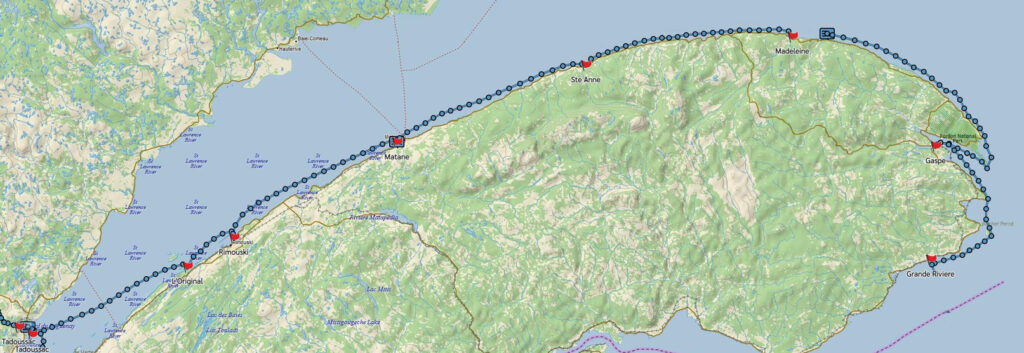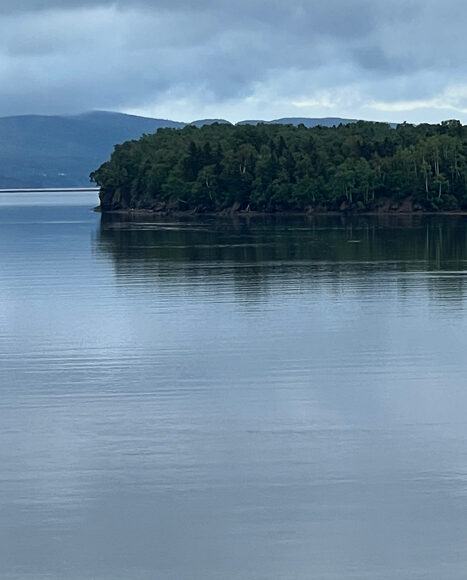We departed Tadoussac on July 30th and crossed the St. Lawrence to the southern shore. Our friends Frank and Marie-Claude from SV Komeekha had left the day before after cruising the Saguenay River together. They had sailed down the St. Lawrence the year before and shared insights about the marinas, anchorages, routes and even weather. The distances between safe anchorages were greater along the northern shore of the St. Lawrence Estuary, they said, and we would find warmer temperatures along the southern shore – a key factor!
Our destination was Parc National du Bic, specifically the anchorage in Anse à l’Orignal (Moose Cove, in English.) Our friends told us that there would be seals along the shoreline. And while we did not see any seals or moose, the bay was beautiful — a place that would be lovely to hang out for a few days. We shared the bay with several other sailboats, but we stayed further back in the bay, not wanting to anchor right on top of them.
Weather
At this point in the season, the weather was driving our timetable. While we would have loved to chill in the bay, we had to push on to the town of Rimouski the next morning. It was a short 15 nautical mile (nm) run and we were able to use our staysail. With the engine running at low RPMs we maintained 7 knots speed-over-ground.
Rimouski offers a nice marina, a nearby chandlery, provisions, restaurants — nearly everything a boater might need. The diesel engine was due for an oil change and we needed oil; unfortunately, the chandlery did not have the weight we required. We did find a fabulous seafood shop down the road and treated ourselves to some crab cakes, chowder, and local fish to grill. The Bistro at the marina was also a great place to have a beverage or two and they even let us have a pizza delivered there!
For the rest of our journey on the St. Lawrence, the distances between stops would range from 40-75nm, forcing us to take advantage of weather windows and early morning departures.
Matane, QC – Commercial Harbour
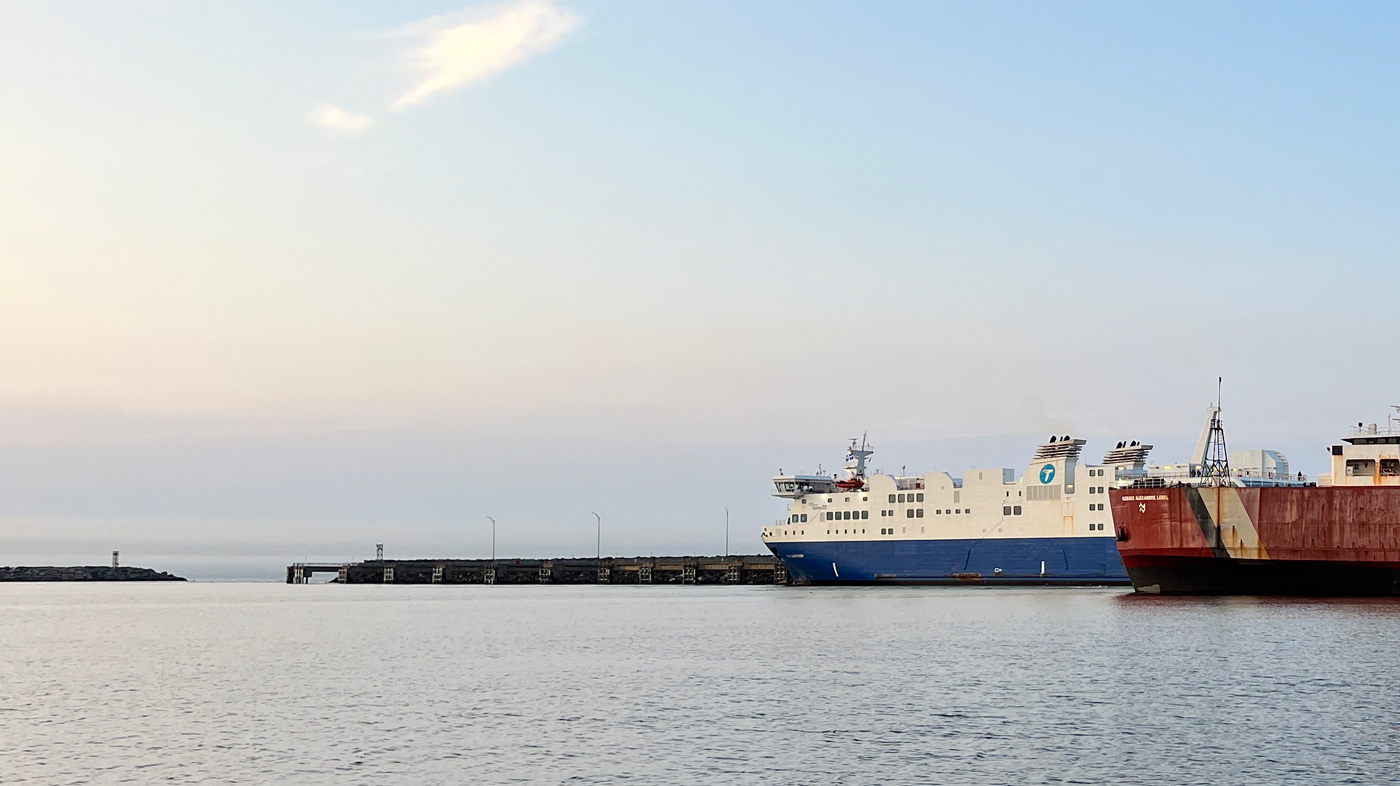
A weather window opened, and we left Rimouski at 0600 on August 5th and arrived early that afternoon in Matane, Quebec. The entire 46 nautical miles was in thick fog and no wind. We had hoped to stay in the marina in Matane, but they had no space for our 50 feet. So we dropped anchor in the commercial harbour. What it lacked in aesthetics, it made up for in price: free! Surrounded by fishing boats, moored barges and a large car ferry that came in right after us — we were the only recreational boat in the harbour. Our evening companions included numerous harbor porpoises and loons!
The next morning we awoke to the sounds of fishing boats heading out, so quickly weighed anchor to make sure we were not in their way. Another 0600 start but we had over 50nm to go and needed to arrive early.
St-Anne des Monts
Our next destination along the southern shore of the St. Lawrence was St-Anne des Monts. A charming town with a great marina. The entrance was very easy with a huge turning basin. We spent considerable time circling the basin as our reservation could not be found. Let’s just say that language may have been part of the issue in finding our reservation! As soon as one of the staff members showed up whose English was a bit better, our reservation was quickly found, and we moved to the end of the main dock.
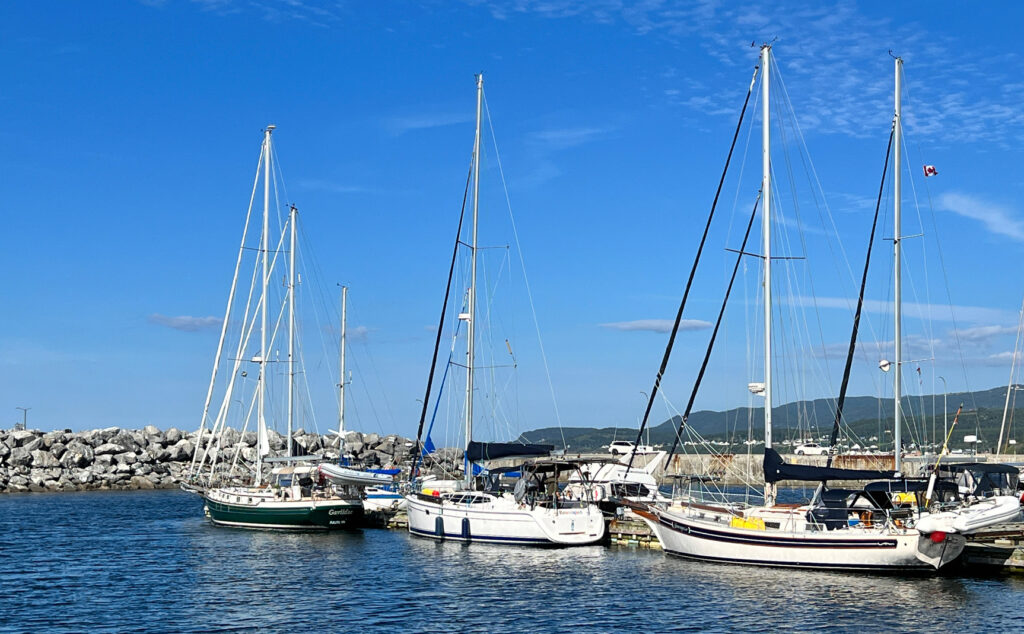
The predicted foul weather caught up to us and we ended up staying several nights in St-Anne des Monts. While there, we met Don and Sheryl from Ontario on their 40-foot sailboat Huntress and learned they were heading our direction and with the same timeline. Like us, they had started earlier in the season on Lake Ontario. We shared a few cocktails and meals and more than a few laughs over the next few days!
For my birthday, Dan and I splurged a bit and went to dinner at Auberge Chateau Lamontagne, a lovely restaurant across the bay and uphill from the marina. We enjoyed the views and fabulous food!

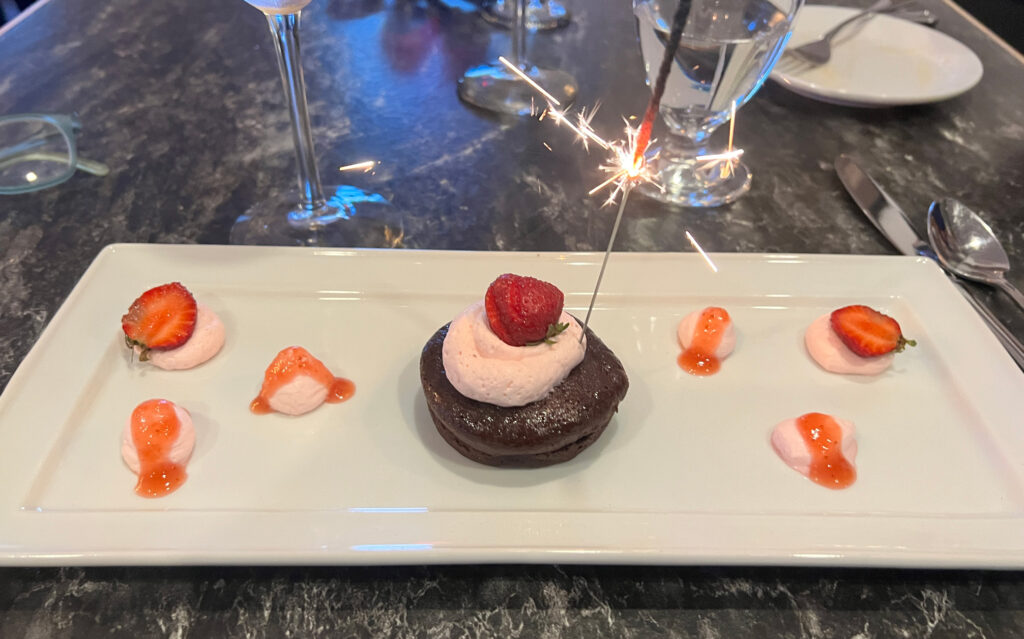
Boat on the Rocks

On our second morning in St-Anne des Monts, numerous rescue vehicles and a small crowd of people gathered along the breakwall and road on the east side of the marina. The new owner of a small sailboat had tied to cleats at the end of the breakwall during high tide but didn’t consider the tide change — or perhaps had too many drinks to remember where the boat was tied.
According to the local fire department, the boat ended up hanging from the cleats as the tide went out and was battered against the breakwall by the heavy surf brought on by the foul weather. They had to cut it away and drag it toward shore. The mast, boom and rudder were torn off and the hull damaged. The boat ended up on the shore along with all kinds of debris spread out along the beach.
We offered to help with the clean-up, but we were assured by the Canadian Coast Guard that they had it under control.
Riviere-la-Madeleine — Exceptional!
With a slight break in the weather, we cast the lines off on August 10th and headed to our next destination — Rivière-la-Madeleine. This was another spot that Frank and Marie-Claude recommended as a worthwhile stop. The star attraction of this tiny village is a fabulous restaurant at the tiny marina called La Capitainerie des Deux Soeurs (the Captaincy of the Two Sisters), or just Capitainerie. We always listen to our Quebecois friends when they are sharing this kind of information! SV Huntress was also heading to this marina. We were lucky to get permission to dock — the marina has just 20 slips, including four for transients like ourselves.
It was an extremely rough day on the water, with east winds running in contrast to the tide and current direction of the St. Lawrence. The swells made for an uncomfortable ride, which was hard on Dan who gets severe headaches on rough seas — mal de mer in French. While he rested, I manned the helm and was rewarded with having a porpoise alongside for a short while. We also sailed through the middle of a pod of seals. The seals popped up all around the boat and too late for me to steer out of their way. I guess they just wanted to get a better look at our beautiful boat!
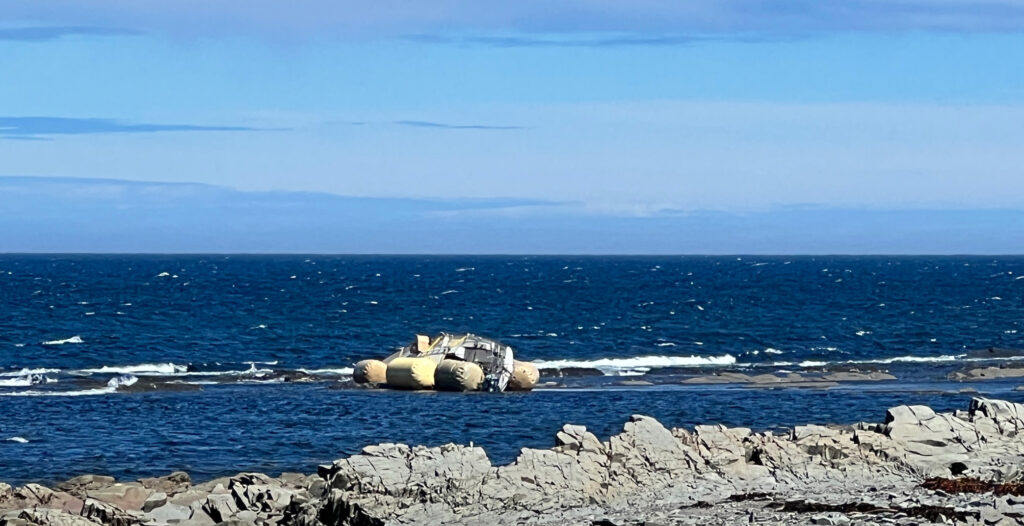
We arrived at Rivière-la-Madeleine as the sun was descending quickly to the horizon. Dan had already talked to the harbourmaster who had given him our slip assignment. We would be arriving after the marina office closed, but the harbourmaster — who spoke only French — assured us someone would be on our dock to help direct us in and help land the boat.
Another Boat on the Rocks
As we approached the tiny harbour, we noticed another sailboat on its side on the rocks on the east side of the channel. This was a much larger sailboat than the boat wrecked in St-Anne des Monts. This boat was equipped for cruising. Dan was on deck preparing docklines and fenders. My confidence of being at the helm did a little hiccup, but we were too close for me to dwell on it! Waves were pushing us into the harbour on a rising tide, it seemed we were going to surf right into the shore. Complicating the situation was a large area just inside of the breakwall marked with floats indicating hazards to get around to reach our dock, which was closest to the breakwall. We would have to steer around rocks, shoals, posts or who-knows-what-all were hiding below the surface!
Blinded by the Light
Just as I turned Gaviidae to starboard toward the docks, the sun parked on the ridgeline of the hill behind the docks and beamed directly in my eyes. I was immediately blinded and the buoys and weathered docks disappeared in the glare. Slowing the engine, I relayed to Dan via our headsets that I could not see the dock at all! Once we were behind the breakwall, the tide was no longer a factor and I inched forward to maintain steerage with little sense as of where we were relative to the buoys or the dock!
With Dan portside guiding us in to secure our landing, I tried to shake off fear of striking unseen hazards to starboard! He tried to relay distances to the nearly invisible dock and the barely visible hazard buoys and to get us aligned with the dock. Once past the hazard markers, I realized there were people on the dock — all in silhouette. Barely able to make out the dock against the dark water, Dan suddenly warned me that Gaviidae’s hull was about to strike the corner of the dock! I popped the bow thruster to starboard, adjusted the wheel and eased in alongside the dock. Hands reached out from the dock and grabbed our lifelines and stanchions to stabilize us and allow the fenders to do their job. We managed to glide in without incurring any damage.

The Audience
Diners at the Capitainerie restaurant had been watching our approach and as soon as we rounded the breakwall a crowd descended onto our dock and finger pier en masse as the restaurant had just closed for the evening. They joined the harbor master and the crew from a nearby pleasure boat waiting on our narrow finger pier. As we were landing and securing docklines, Dan was getting inundated with questions in French from non-sailors about where we came from, what type of boat were we sailing, what did Gaviidae mean, etc. Docking with an audience — always the best!
SV Huntress
Once the crowd thinned out, we had a chance to discuss with the harbourmaster where to park SV Huntress. Based on what we were seeing on AIS (Automatic Identification System), Huntress was going to arrive well after dark. The breakwall was too close for Huntress to safely pass beside us in the dark and there were no more slips for a large sailboat. Our only option was to move Gaviidae further down the dock, which was vacant. Huntress would take our spot and tie up right behind us.
We heard them hail as they got closer, and using AIS, I relayed instructions to them and warned them to slow down as they entered the harbor. I felt like a sports commentator coaching them past the breakwall, around the hazard area and in to the dark finger pier. Besides the radioed instructions in their native English, everyone was armed with flashlights or headlamps to illuminate their approach and landing. They docked without incident and without the crowd that greeted us! For those who have ever docked a boat in a marina with no lights and/or unhelpful distractions, you know how difficult it can be!
Weather, Again
Another weather front was forecast for the area so both boats planned on spending two nights at Madeleine. On Saturday, SV Huntress cast off heading for Rivière-au-Rinard at first light to have some engine issues addressed. We planned to depart as well but the winds picked up before we were ready to depart and prevented a safe departure. Since we so close to the breakwall, there was no way to safely spring the boat off the dock and we didn’t want to add our boat to the rock pile!
So, we spent another day in Madeleine — this time entertained by repeated attempts of a salvage service and the Coasties (the same crew as in St-Anne des Monts) trying in vain to float the sailboat off the rock it was impaled on. Even with floats and two tugboats pulling, the boat stayed firmly planted.
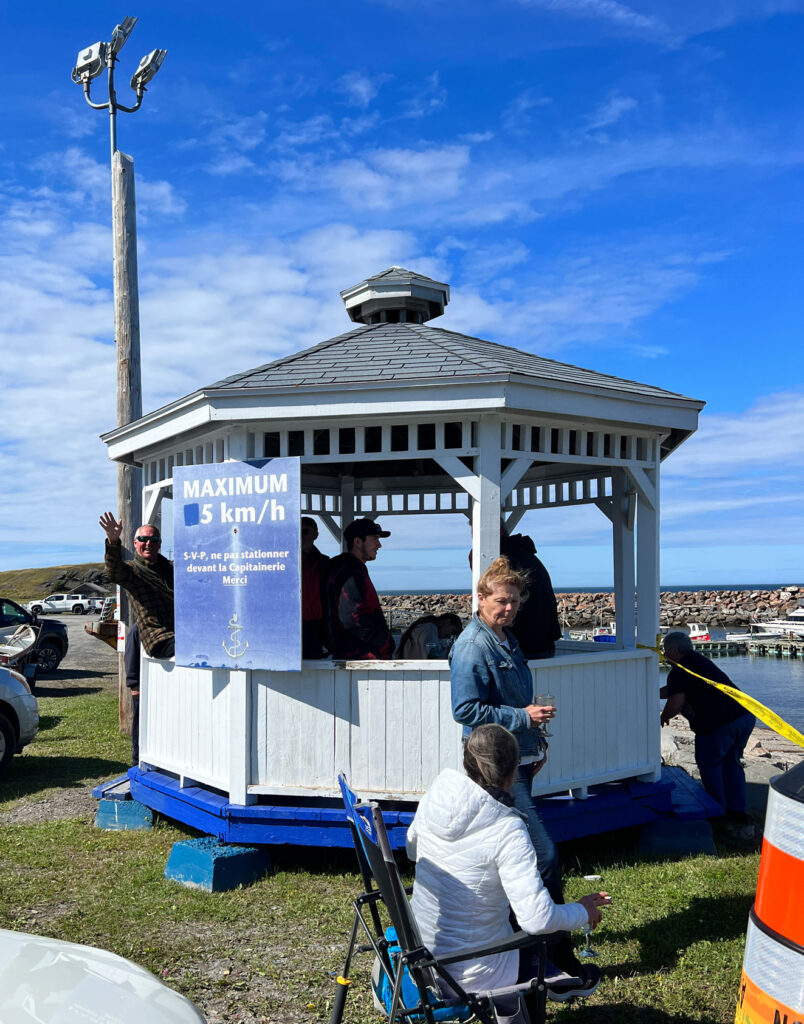
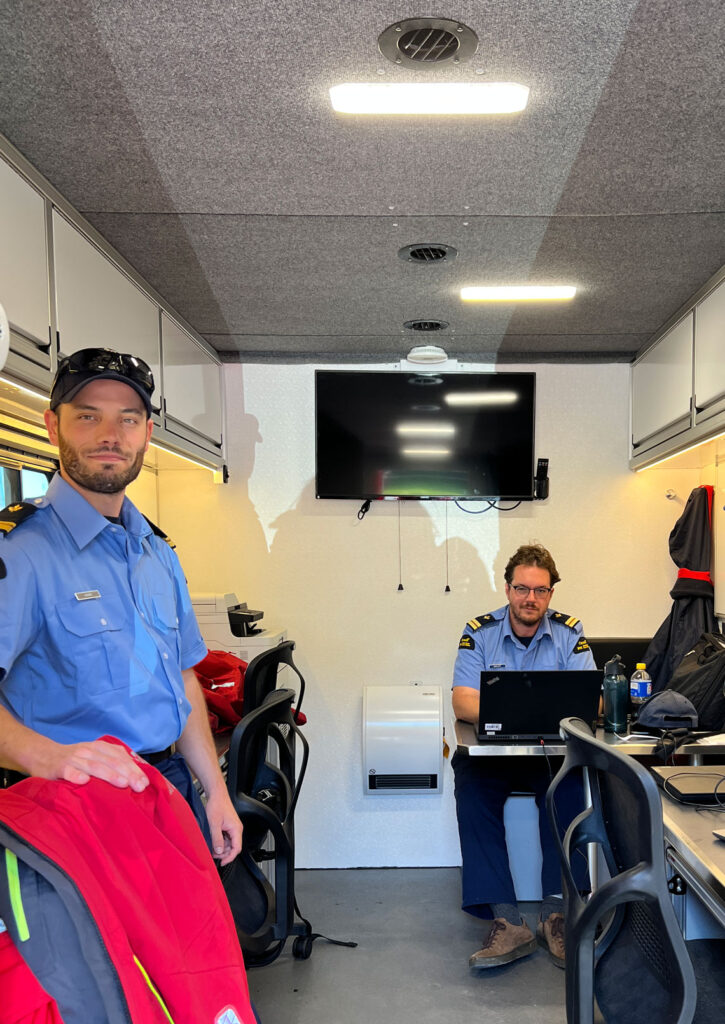
The operation continued throughout the day and as word spread through the village, locals brought their lawn chairs and beer coolers to watch the proceedings. By late afternoon, the tide receded, the operation was scratched and the audience departed.
Rock Crabs
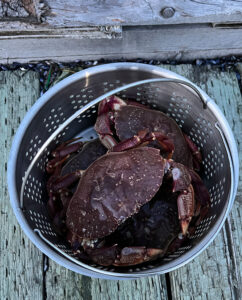
When we first arrived at Madeleine, we saw a fishing boat working crab traps outside the harbour. Having retrieved their catch the crabbers returned to the harbour after the salvage operation ceased. They docked on out finger pier, across from us. A large refrigeration truck pulled up to the top of the dock. Large containers of rock crab were off-loaded and trundled up to the refrigeration truck. The crew on the fishing vessel consisted of a young man and woman. The woman spoke English and I chatted a bit with her as she worked. I asked it was possible to buy some crab. The answer was yes and for $5 Canadian, we got four lovely rock crabs. I was assured that while they were small, they would be delicious. Since we had reservations for dinner at the Capitainerie, the rock crabs were stowed in the refrigerator.
We departed at 0515 the next morning, our wallets a little lighter after enjoying too many meals at La Capitainerie des Deux Soeurs.
Gaspé
With repeated corrections, Dan finally got me to pronounce Gaspé properly – “gas PAY” as we cruised along the north and east shores of the Gaspé Peninsula. Our destination was the city of Gaspé, Quebec, located on the large bay at the eastmost end of the peninsula. The name, “Gaspé,” is said to come from the Mi’kmaq First Nations tribe word “gaspe’g,” meaning “end.” It references the end of the peninsula.
Our early departure was necessary because we had 75nm to cover and we wanted to arrive during daylight hours. The wind that had delayed our departure from Madeleine had backed off some, but it still was on our nose as we steered east by southeast. We deployed the mainsail and the staysail close-hauled to get some use out of winds ranging from 7 to 16 knots. We hugged the shoreline to avoid the nasty swells we experienced during our previous outing.
Grande-Vallée Winds
As we approached the village of Grande-Vallée an hour or so after our departure, we were hit with the notorious mountain wind streaming off the Gaspé Peninsula. The Grand-Vallée winds that day were part of the same weather system driving the easterly winds that kept us in Madeleine the past few days. Winds sweeping across the St. Lawrence that are intercepted by the rugged Gaspé Peninsula get channeled around high mountains, through valleys and across plateaus. They often gain speed and force before sweeping out coastal openings like the Rivière de la Grand-Vallée and onto the St. Lawrence estuary.
The abrupt high wind reminded us of the katabatic winds we experienced years before when sailing the Ionian Sea off Greece. Those winds were always mid-to-late afternoon on warm, calm days when gravity pulls cool, high-density air down from the mountainous islands to displace warmer, less dense air over the sea. They could be just as abrupt and just as high. When the Grand-Vallée wind hit Gaviidae that morning, our anemometer (wind speed indicator) at the top of the mast shot from 8 knots per hour to over 20 knots in mere seconds. The wind remained at that level for three or four nautical miles before it settled back down to 10 knots. The sudden increase was sufficient to heel the boat, causing a few things to be dumped off the cockpit table — including our binoculars. Oops.
Marine Life
It was great day for spotting ocean-going mammals and seabirds – we counted 5 whales, 24 porpoise, 2 seals, and 10 of the amazing Northern Gannet diving birds. The area around Gaspé is known for these birds – with their almost 6 foot wingspan, they float along in the air currents and then suddenly tuck their wings and dive straight into the water at lightning speed! Without fail, they pop back up, with fish in beak. Very entertaining!
Big Water
As we approached the end of the peninsula, the waves became further apart as the impact of the Atlantic Ocean and the Laurentian Channel was apparent. This meant far less pounding and a more comfortable ride. Dan was testing out some motion-sickness Sea-bands around his wrists and it was apparent that they were helping fend off the headaches as he was able to enjoy the day.
The tip of the Gaspé peninsula juts out like a long, thin finger. With amazing cliffs and scenery, we continued to hug the coast. The winds continued to blow from the southeast allowing us to douse the engine and enjoy the beautiful afternoon with no rumbling, iron genny (engine) for the last couple of hours of the day. Baie de Gaspé runs inland 13nm from the Gulf of St. Lawrence.
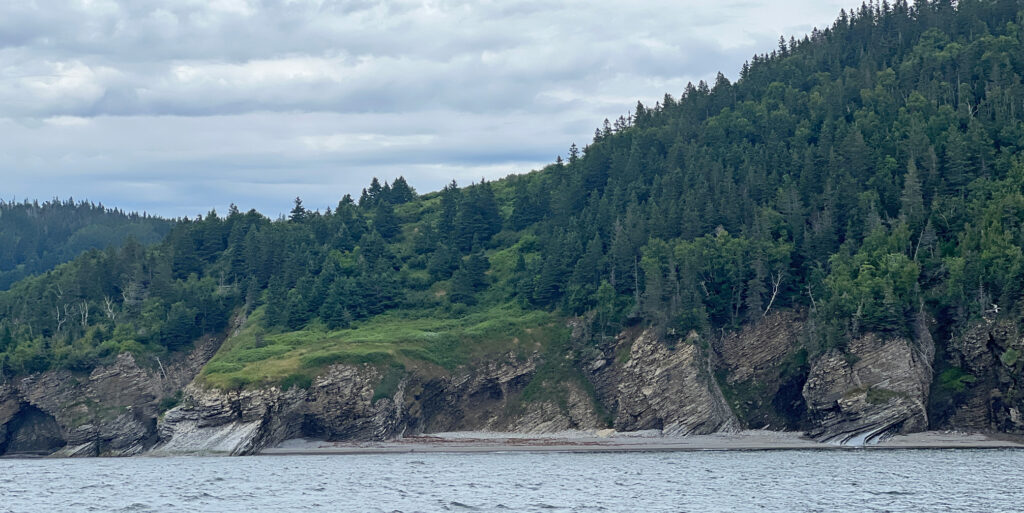
Anchoring in Gaspé
We dropped anchor in the bay not far from the main marina in Gaspé. Across the bay from our anchorage was the city that was spread across a slope rising from the bay. It was a lovely spot that we shared with one other sailboat with the twinkling lights of Gaspé as the sun went down. Dan cooked up the rock crabs and yes, they were delicious! It had been a long day and we slept like logs!
Anxious to continue and keeping an eye on the weather, we weighed anchor and headed for the fishing village of Grande-Rivière. Before departing, we took on fuel, propane and water at the Gaspé marina and enjoyed a healthy breakfast in the little restaurant.
Our heading out of the large bay was directly into the wind but we were still able to get a little bump in speed using the staysail. We saw three black and grey boats speeding along the shoreline. Within a short time, they turned around and raced across the bay towards us – another friendly visit by the RCMP checking our documentation. It is a bit disconcerting having three official boats with blue lights flashing surrounding the boat!
The Birds
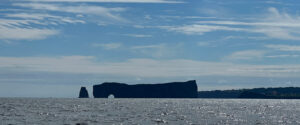
Our route took us past Rocher Percé – one of the most photographed locations in Quebec and the St. Lawrence. It is impressive to sail by!
We also went by Ile Bonaventure, home to some 100,000 nesting Northern Gannets. We dropped anchor on the south shore for lunch just to appreciate their amazing acrobatics and color. The entire island was swarming with the white birds!
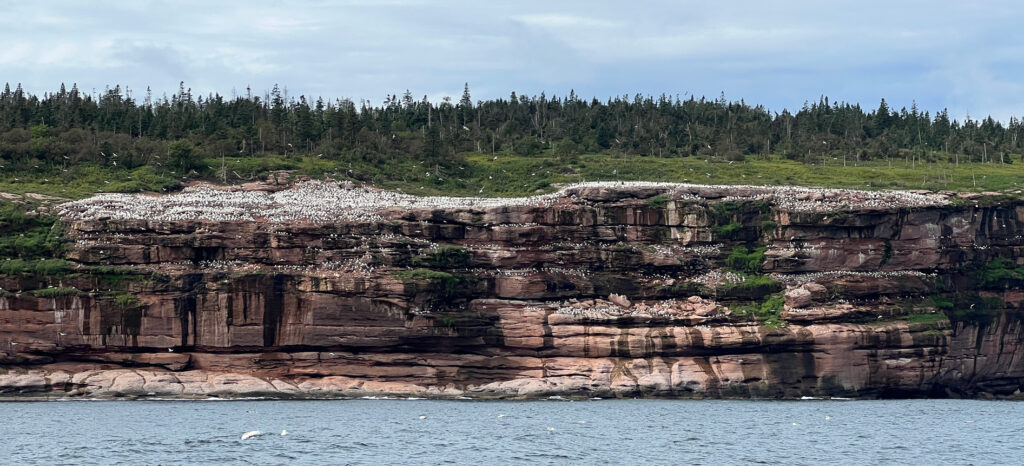
Grande-Riviere
We pulled into the small fishing marina at Grande-Rivière around 1730. There was no response to our hails on the radio, so we grabbed an open slip that was currently in use by locals fishing off the dock. They simply smiled and moved further over to give us room to tie up.
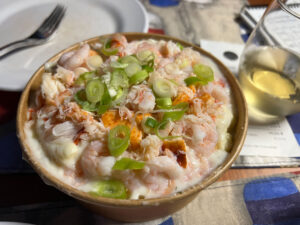
A short while later, Jean-Pierre Beaudin, the harbourmaster, showed up and presented his business card to us. He accepted our payment for the slip and proceeded to tell us about learning to speak English on a fishing vessel some 20 years earlier. He was very proud of being bi-lingual! We did our best to understand him, nodding our heads wherever we thought appropriate. We did learn that the little fishing shack nearby had great food.
Taking Jean-Pierre’s advice, we promptly went over to the establishment – a cross between a shack and a food truck. We both agreed that the fresh chowder was the best we’d ever had! Loaded with shrimp, clams and fish!
Goodbye Quebec
Grande-Rivière was our last stop in Quebec. Our next destination was New Brunswick, some 89nm away across the Bay of Chaleur.
We thoroughly enjoyed all of our stops along the way in Quebec. Beautiful country, friendly people and fabulous food. Till the next time!
July 30-August 15, 2023 320 Nautical Miles, 916.6 Nautical Miles Total 48°23.648’N 064°29.696’W
